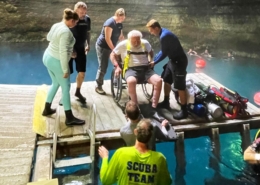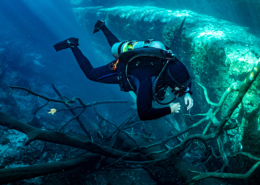The Most Accurate Weight Check
By Harry
A properly weighted diver with no air in his BC will float at eye level. You find this statement, or one like it, in most entry-level diver manuals. If only it were true.
In reality, where a properly-weighted diver floats at the beginning of a dive depends on several factors. Chief among them:
- Exposure suit type and compressibility.
- Cylinder capacity.
For example:
- Take a properly-weighted diver in a 7 mm farmer-john-style wetsuit using an 11-liter aluminum 80. They may actually float at or near eye level at the beginning of a dive.
- Put the same diver in a shell-type drysuit and give him a 13-liter steel 95. You may discover they sink at the beginning of the dive if properly weighted.
Accounting for differences in cylinder capacity and the weight of gas consumed during a dive is essential. Let’s say you begin your dive with a full cylinder and end it with at least 35 bars/500 psi remaining.
- If using an 11-liter aluminum 80, you will be as much as 2.25 kg/5.00 lbs more buoyant at the end of the dive. This is the weight of the gas you used during the dive.
- If using a 13-liter steel 95, you will be as much as 3.0 kg/6.5 lbs more buoyant and the end of the dive due to gas consumed.
If your pre-dive weight check fails to account for this, it won’t be accurate.
There is also disagreement over whether to perform your weight check with your lungs half full or completely full.
- Your average buoyancy during a dive depends on something called mid-tidal volume. This is the halfway point between inhalation and exhalation. It is why you should perform any surface weight check with your lungs half full.
- Maximum lung volume or vital capacity can vary significantly among divers. Let’s say you have a diver with an unusually large vital capacity. They perform a weight check with their lungs completely full. Because of their unusually large lung capacity, they could end up thinking they need more weight than they actually do.
Pre-dive weight checks can have value. They may help determine if you are significantly overweighted or underweighted. But they only work if you know where you should float. How do you determine this?
A common goal
No matter what their equipment configuration, all divers share a common goal. This goal is to wear the least weight possible without having to fight to stay down. Why is this important? For two reasons:
- It’s safer: The less weight you wear, the more likely you are to survive at the surface.
- It’s easier to control buoyancy: The less weight you wear, the fewer buoyancy adjustments you must make with your BC.
Both points require an explanation.
Using less weight is safer
When an overweighted diver surfaces, he must immediately inflate his BC to get his head out of the water. Should he have difficulty doing so (say, if BC failure occurs), he must struggle to stay at the surface until he can drop some weight. Panicky divers often fail to do this and risk drowning.
In contrast, a properly-weighted diver experiencing a BC problem must exert little or no effort to stay at the surface while deciding whether to drop weight. If wearing a thick wetsuit, a properly weighted diver may float at the surface with no effort, provided he breathes from his regulator or snorkel.
Of course, unless the boat or shore is close by, divers in this situation are probably best off dropping at least some weight. But if properly weighted, they will have time to think this through carefully.
Using less weight makes buoyancy control easier
If properly weighted, you need only add air to your BC to compensate for exposure suit compression. But let’s say you are wearing 5 kg/11 lbs of weight you don’t need. Now you must compensate not only for suit compression but for the compression of a 5 kg/11 lb air bubble inside your BC. This air bubble is there solely to offset the unnecessary weight.
It means you must make buoyancy adjustments much more frequently. Even a small change in depth may require you add or vent air from your BC.
The best place to conduct weight checks
If your goal is to always use the least weight possible, the best place to conduct a weight check is at the end of a dive, not the beginning. Specifically, you want a time and place where:
- You have 35-50 bars/750-500 psi remaining in your cylinder.
- You are at the shallowest depth you will likely spend any significant time.
‘Sounds pretty much like your safety stop, doesn’t it? It is. This is where your most accurate weight check can take place.
Every time you make a safety stop, make sure you can hover effortlessly with no air in your BC.
- If you can only hover by adding air, remove some weight before the next dive.
- If, on the other hand, you find yourself fighting to stay down with an empty BC, add some weight before diving again.
Because you perform safety stops at the end of every dive, each dive provides the opportunity to perform a weight check. It requires no extra time or effort on your part. It also doesn’t matter if:
- You are wearing a highly-compressible wetsuit, a non-compressible dive skin or something like a drysuit, in which you maintain a constant volume throughout the dive.
- You are using a smaller cylinder, such as an 11-liter aluminum 80, or a larger cylinder, such as a high-capacity steel.
The same procedure works regardless of equipment.
You learn interesting things
By making a safety-stop weight check part of every dive, you can learn several interesting things about yourself and your equipment. For example:
- If diving with a 7 mm, farmer-john-style wetsuit, you may indeed float at eye level upon surfacing. This is due to the suit’s highly-compressible nature.
- In contrast, let’s say you dive a non-compressible skin or a drysuit in which you maintain a constant air volume. You may discover just the top of your head touches the surface at the end of the dive.
Changes over time
It’s not unusual for your weight needs change over time. Well-known dive retailer and educator John Wall would relate how, during a week-long dive vacation, he would need progressively less weight.
John attributed this to that fact as the week progressed, he became more and more relaxed. As his mid-tidal volume dropped, so did his need for weight.
Make a record
The fact cylinder size and exposure suit type have a significant impact on how much weight you need underscores the need for dive logs. A dive log is a perfect place to record how much weight you need for different combinations of gear.
Remember also you will need 2-3 kg/4-6 lbs more weight in salt water than you will when using the same equipment in fresh water.
Learn more
The ability to effortlessly control buoyancy is the hallmark of an expert diver. Proper weighting is the foundation of good buoyancy control. You can learn to become just such an expert in the SDI Advanced Buoyancy Diver course. Ask your instructor or SDI Dive Center for more information.










Hinterlasse einen Kommentar
An der Diskussion beteiligen?Hinterlasse uns deinen Kommentar!